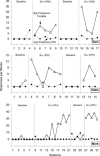Assessing object-to-picture and picture-to-object matching as prerequisite skills for pictorial preference assessments
- PMID: 16463535
- PMCID: PMC1309717
- DOI: 10.1901/jaba.2005.161-04
Assessing object-to-picture and picture-to-object matching as prerequisite skills for pictorial preference assessments
Abstract
Tangible and pictorial paired-stimulus (PPS) preference assessments were compared for 6 individuals with developmental disabilities. During tangible and PPS assessments, two edible items or photographs were presented on each trial, respectively, and approach responses were recorded. Both assessments yielded similar preference hierarchies for 3 participants who could match pictures and objects but different hierarchies for 3 participants who could not. Reinforcer assessments verified that items identified as high preference on PPS assessments functioned as reinforcers only for participants with matching skills.
Figures


References
-
- Graff R.B, Gibson L. Using pictures to assess reinforcers in individuals with developmental disabilities. Behavior Modification. 2003;27:470–483. - PubMed
Publication types
MeSH terms
LinkOut - more resources
Full Text Sources

